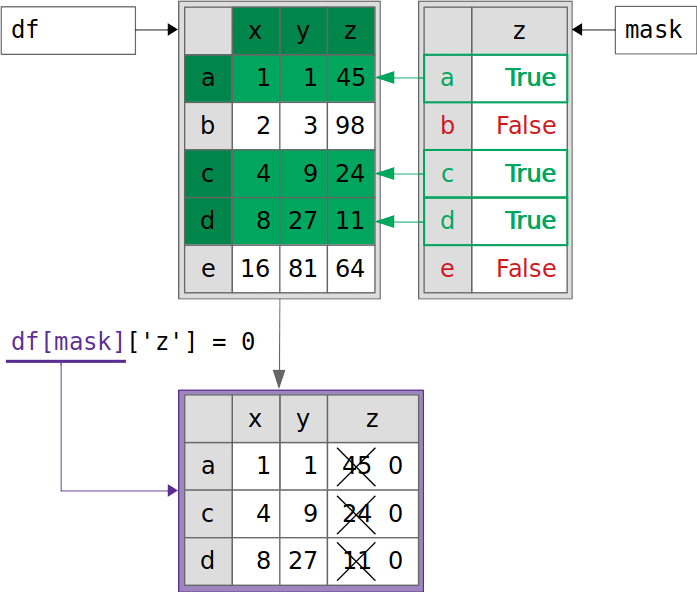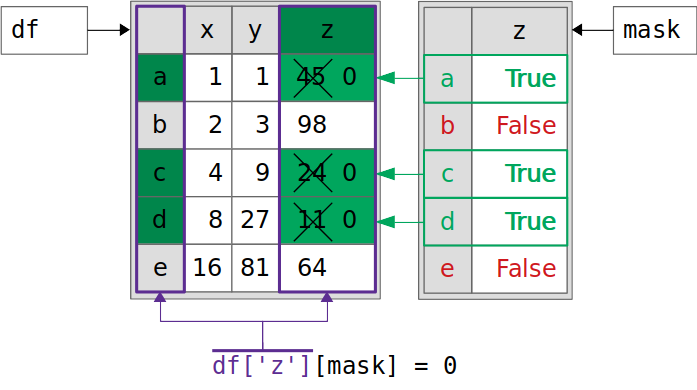This notebook is primarily taken from SettingWithCopyWarning in Pandas: Views vs Copies, by Mirko Stojiljković.
| x | y | z | |
|---|---|---|---|
| a | 1 | 1 | 45 |
| b | 2 | 3 | 98 |
| c | 4 | 9 | 24 |
| d | 8 | 27 | 11 |
| e | 16 | 81 | 64 |
Create a boolean array named mask that has a True value for all rows in df for which the value in column 'z' is less than 50.
And look at the rows in df for which mask contains a value of True
| x | y | z | |
|---|---|---|---|
| a | 1 | 1 | 45 |
| c | 4 | 9 | 24 |
| d | 8 | 27 | 11 |
Now we want to set all the values in column z of df for those rows where mask contains True.
Here's an illustration that shows what's happening.

Why does the application of mask return a copy of df rather than a slice? NumPy, and therefore Pandas, wants to keep all the elements of a Series in a contiguous block of memory. From High-performance embedded computing by Cardoso, Coutinho, and Diniz:
To exploit SIMD units, it is very important to be able to combine multiple load or store accesses in a single SIMD instruction. This can be achieved when using contiguous memory accesses, e.g., in the presence of unit stride accesses, and when array elements are aligned.
Perhaps surprisingly, you don't get the warning message if you execute the following cell.
| x | y | z | |
|---|---|---|---|
| a | 1 | 1 | 0 |
| b | 2 | 3 | 98 |
| c | 4 | 9 | 0 |
| d | 8 | 27 | 0 |
| e | 16 | 81 | 64 |
The picture below illustrates why 
Pandas knows that df['z'] is not a copy of the data in df, and implements the assignment statement directly on that portion of memory.
Implementation of the [] operator in Python
When creating an object that supports indexing via the [ ] notation, Python requires classes like DataFrame and Series to implement two methods: __getitem__ and __setitem__ (creatively referred to as dunder methods).
So this means that statements like
and
involve 3 method calls:
2 calls to
__getitem__1 call to
__setitem__
These methods can make use of an internal DataFrame / Series method named _is_view in their implementations. If something is a view, it's not a copy.
Using accessor methods for assignment
Stojiljković advises that you:
Avoid chained assignments that combine 2 or more indexing operations like
df[mask]['z'] = 0anddf.loc[mask]["z"] = 0Apply single assignments with just one indexing operation, like
df.loc[mask, "z"] = 0
Other methods that are generally safer include iloc, at, and iat. at/iat allow you to access a single element of a DataFrame / Series by providing a row/column combination.
| x | y | z | |
|---|---|---|---|
| a | 1 | 1 | 0 |
| b | 2 | 3 | 98 |
| c | 4 | 9 | 0 |
| d | 8 | 27 | 0 |
| e | 16 | 81 | 64 |
You can control whether Pandas issues the SettingWithCopyWarning by calling pd.set_option like this:
pd.set_option("mode.chained_assignment", "raise")pd.set_option("mode.chained_assignment", "warn")defaultpd.set_option("mode.chained_assignment", None)
For more information , continue reading Stojiljković's article.